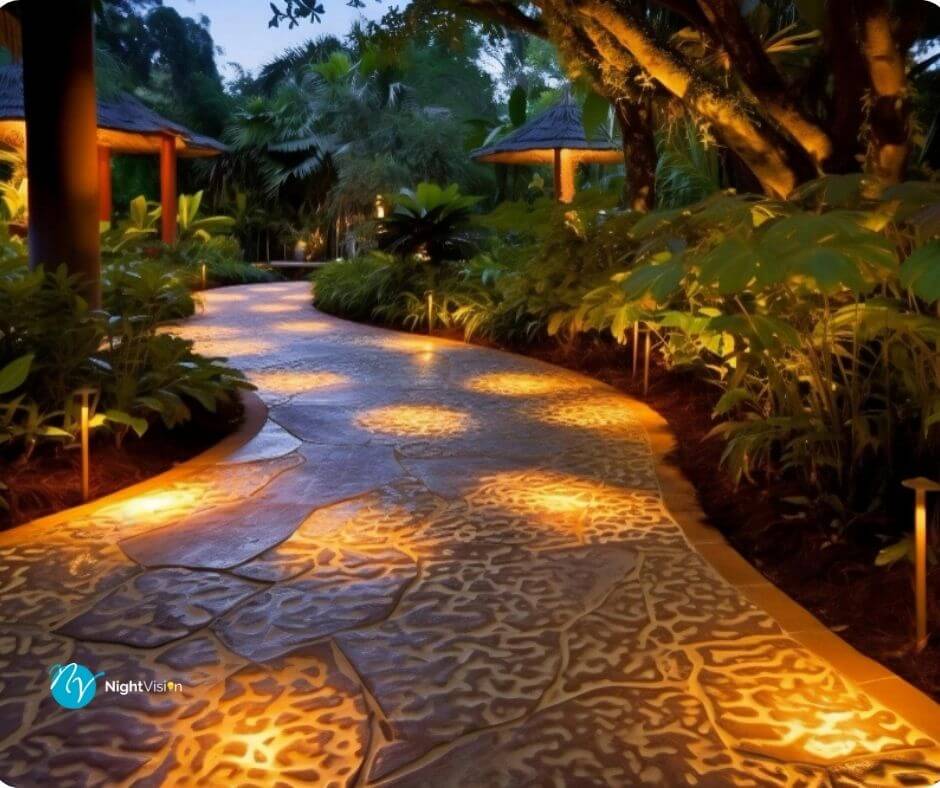Creating the perfect ambiance in outdoor spaces is not just about aesthetics; it’s about transforming your surroundings into enchanting environments that invite relaxation, enhance security, and extend the functionality of your property.
Landscape lighting plays a pivotal role in achieving this, offering a myriad of design possibilities to illuminate and accentuate the beauty of your outdoor areas.
Understanding Ambiance
Understanding ambiance is crucial in landscape design as it sets the tone for the entire outdoor space.
Ambiance is more than just the physical elements; it’s about the emotions and feelings evoked by the environment.
Picture a serene garden bathed in soft moonlight, inviting you to unwind after a long day, or a lively outdoor gathering illuminated by festive string lights, infusing the atmosphere with warmth and conviviality.
By understanding how light, shadow, and the surrounding environment interact, designers can create tailored experiences that resonate with the desires and intentions of the space’s occupants.
Whether it’s a tranquil sanctuary for quiet contemplation or a dynamic social setting for lively gatherings, ambiance serves as the foundation upon which all other design elements are built.
Benefits of Thoughtful Landscape Lighting
The benefits of thoughtful landscape lighting extend far beyond simply illuminating outdoor spaces.
When designed with care and consideration, landscape lighting can have a transformative effect on the aesthetics, functionality, and safety of your outdoor environment. Here are some key benefits:
Enhanced Visual Appeal: Thoughtfully positioned fixtures and strategic lighting techniques can accentuate the architectural features, natural landscapes, and focal points of your outdoor space, creating a visually stunning environment that is equally captivating during the day and night.
Improved Safety and Security: Properly illuminated pathways, driveways, and entry points not only enhance the aesthetic appeal of your property but also improve safety by reducing the risk of trips, falls, and accidents.
Additionally, a well-lit exterior deters intruders and enhances security, providing peace of mind for homeowners.
Extended Usability: With the addition of landscape lighting, outdoor areas such as gardens, patios, and decks can be enjoyed long after the sun sets.
Whether hosting outdoor gatherings, dining al fresco, or simply relaxing under the stars, well-planned lighting allows you to make the most of your outdoor space, regardless of the time of day.
Principles of Landscape Lighting Design
Achieving a harmonious balance between light and shadow is essential in landscape lighting design.
By adhering to principles such as balance, symmetry, layering, and focal point emphasis, you can create captivating outdoor environments that are both visually striking and functionally effective.
Types of Landscape Lighting Fixtures
From path lights that guide footsteps along garden pathways to wall washers that accentuate architectural features, the world of landscape lighting is replete with a diverse array of fixtures suited to various purposes and preferences.
Understanding the characteristics and applications of each type of fixture is crucial in designing a lighting scheme that meets your specific needs and aesthetic goals.
Choosing the Right Lighting Techniques
Different lighting techniques can produce vastly different effects, allowing you to sculpt the ambiance of your outdoor spaces with precision and artistry.
Whether you opt for up-lighting to highlight towering trees, down-lighting to illuminate cozy seating areas, or grazing to emphasize textured surfaces, selecting the appropriate techniques is instrumental in achieving your desired lighting design.
Factors to Consider in Landscape Lighting Design

When planning your landscape lighting design, several factors must be taken into account to ensure optimal results.
Considerations such as property size and layout, existing architectural features, foliage and planting arrangements, as well as the balance between functional needs and aesthetic aspirations, all play pivotal roles in shaping the final outcome of your lighting scheme.
Integration with Other Elements
Landscape lighting should seamlessly integrate with other elements of your outdoor environment, complementing rather than overpowering existing features.
Whether incorporating lighting into water features, hardscape structures, or garden design elements, careful coordination is essential to achieving a cohesive and visually pleasing result.
Energy Efficiency and Sustainability
In an era increasingly focused on sustainability, energy-efficient lighting solutions have become increasingly popular in landscape design.
LED lighting options offer both eco-friendly benefits and cost savings, while solar-powered fixtures provide an environmentally conscious alternative for outdoor illumination.
Additionally, the use of timers and sensors can further enhance energy efficiency by reducing unnecessary energy consumption.
Common Mistakes to Avoid
In the pursuit of creating captivating outdoor lighting designs, it’s important to steer clear of common pitfalls that can detract from the overall effectiveness and appeal of your lighting scheme.
Avoiding mistakes such as over-lighting, under-lighting, inconsistent lighting, and neglecting maintenance requirements is essential in achieving long-lasting and aesthetically pleasing results.
Budget Considerations
While the allure of elaborate lighting designs may be tempting, it’s important to consider budgetary constraints when planning your landscape lighting project.
Balancing the initial investment with long-term savings and weighing the pros and cons of DIY installation versus professional services can help ensure that your lighting design aligns with your financial parameters and goals.
Trends in Landscape Lighting
As technology continues to evolve, so too do trends in landscape lighting design.
From the rise of smart lighting systems that offer remote control and automation capabilities to the growing popularity of color-changing LEDs and minimalist fixtures, staying abreast of emerging trends can inspire innovative approaches to illuminating your outdoor spaces.
Tips for DIY Enthusiasts
For DIY enthusiasts eager to embark on their own landscape lighting projects, thorough research, careful planning, and adherence to safety precautions are paramount.
From selecting the right fixtures and techniques to implementing effective maintenance strategies, incorporating these tips can help ensure a successful and rewarding lighting design endeavor.
Conclusion
In conclusion, mastering ambiance through landscape lighting design is a journey that combines creativity, technical expertise, and a deep appreciation for the beauty of the natural world.
By understanding the fundamental principles of lighting design, selecting the right fixtures and techniques, and integrating lighting seamlessly with other elements of the landscape, designers can create outdoor spaces that are as beautiful as they are functional.
Whether you’re illuminating a sprawling garden estate or a cozy urban balcony, the key lies in harnessing the power of light to create immersive and enchanting environments that invite exploration, relaxation, and enjoyment.
For expert guidance and assistance in bringing your landscape lighting vision to life, contact us at NV Lighting. Our team of professionals is dedicated to helping you create outdoor spaces that are as stunning as they are sustainable.
FAQs
What is ambiance in landscape lighting design?
Ambiance in landscape lighting design refers to the overall atmosphere and mood created by strategically illuminating outdoor spaces. It encompasses the emotional and sensory experiences evoked by the interplay of light, shadow, and surrounding environment.
What are the benefits of thoughtful landscape lighting?
Thoughtful landscape lighting enhances visual appeal by accentuating architectural features and natural landscapes, improves safety and security by illuminating pathways and entry points, and extends outdoor usability by allowing enjoyment of outdoor spaces after dark.
What principles should be considered in landscape lighting design?
Principles such as balance, symmetry, layering, and focal point emphasis are essential in achieving a harmonious and visually striking landscape lighting design.
What types of landscape lighting fixtures are available?
There is a diverse array of fixtures available for landscape lighting, including path lights, wall washers, up-lights, down-lights, and grazing lights, each suited to different purposes and preferences.
How do I choose the right lighting techniques for my outdoor space?
Select lighting techniques such as up-lighting, down-lighting, or grazing based on the desired effects and features of your outdoor space, ensuring they align with your aesthetic goals and functional needs.
What factors should I consider when designing landscape lighting?
Considerations such as property size and layout, existing architectural features, foliage arrangements, and the balance between function and aesthetics are crucial in shaping your landscape lighting design.
How can I integrate landscape lighting with other elements of my outdoor environment?
Landscape lighting should seamlessly complement other outdoor elements such as water features, hardscape structures, and garden design, enhancing their visual appeal without overpowering them.
What are some energy-efficient options for landscape lighting?
LED lighting and solar-powered fixtures are popular energy-efficient options for landscape lighting, offering eco-friendly benefits and cost savings. Additionally, timers and sensors can enhance energy efficiency by reducing unnecessary energy consumption.
What common mistakes should I avoid in landscape lighting design?
Common mistakes to avoid include over-lighting, under-lighting, inconsistent lighting, and neglecting maintenance requirements, all of which can detract from the effectiveness and appeal of your lighting scheme.
How can I ensure my landscape lighting project stays within budget?
Balancing initial investment with long-term savings, considering DIY versus professional installation, and prioritizing lighting elements based on budget constraints are essential in ensuring your project aligns with financial parameters.
What are some current trends in landscape lighting design?
Current trends include the adoption of smart lighting systems, the use of color-changing LEDs, and the popularity of minimalist fixtures, all of which offer innovative approaches to illuminating outdoor spaces.



